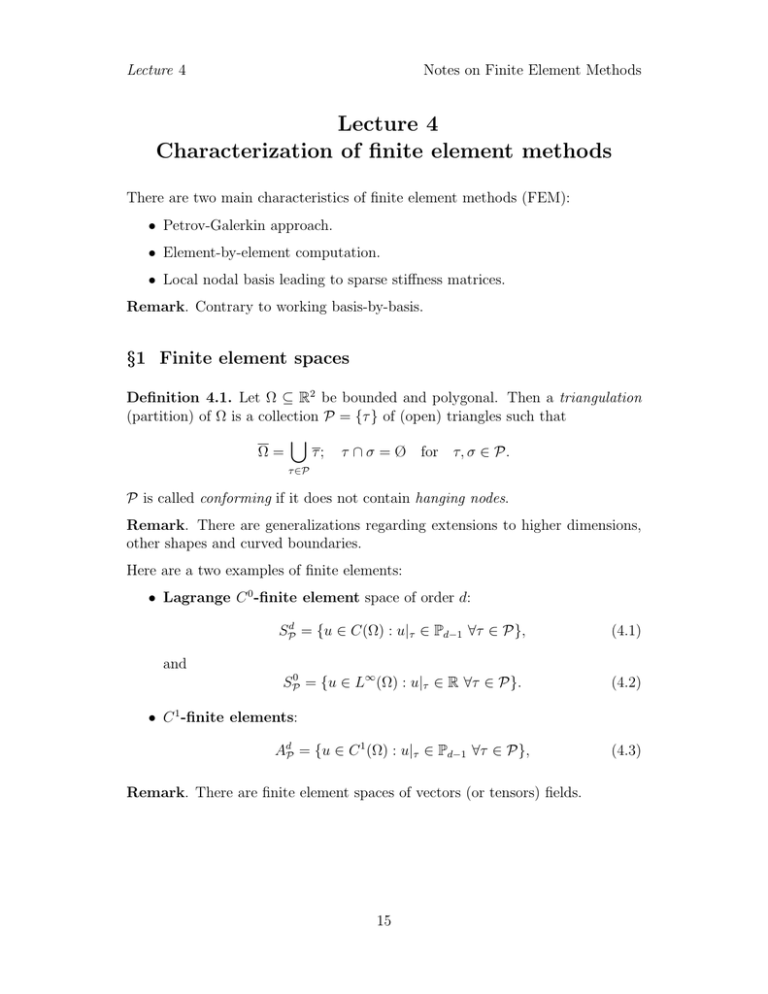Lecture 4 Characterization of finite element methods
advertisement

Lecture 4
Notes on Finite Element Methods
Lecture 4
Characterization of finite element methods
There are two main characteristics of finite element methods (FEM):
• Petrov-Galerkin approach.
• Element-by-element computation.
• Local nodal basis leading to sparse stiffness matrices.
Remark. Contrary to working basis-by-basis.
§1 Finite element spaces
Definition 4.1. Let Ω ⊆ R2 be bounded and polygonal. Then a triangulation
(partition) of Ω is a collection P = {τ } of (open) triangles such that
�
Ω=
τ ; τ ∩ σ = Ø for τ, σ ∈ P.
τ ∈P
P is called conforming if it does not contain hanging nodes.
Remark. There are generalizations regarding extensions to higher dimensions,
other shapes and curved boundaries.
Here are a two examples of finite elements:
• Lagrange C 0 -finite element space of order d:
SPd = {u ∈ C(Ω) : u|τ ∈ Pd−1 ∀τ ∈ P},
(4.1)
SP0 = {u ∈ L∞ (Ω) : u|τ ∈ R ∀τ ∈ P}.
(4.2)
and
• C 1 -finite elements:
AdP = {u ∈ C 1 (Ω) : u|τ ∈ Pd−1 ∀τ ∈ P},
Remark. There are finite element spaces of vectors (or tensors) fields.
15
(4.3)
Lecture 4
Notes on Finite Element Methods
§2 Finite elements
Definition 4.2 (Ciaret). A finite element is a triple (τ, S, N ) where
• τ ⊂ Rn is a domain with piecewise smooth boundary (element domain).
• S is a finite-dimensional space of functions on τ (shape functions).
• N = {N1 , ..., Nk } is a basis for S ∗ (nodal variables).
Example for v ∈ S,
N1 (v) = v(x1 )
N2 (v) = v(x2 )
and maybe
N3 (v) = v � (x1 )
N4 (v) = v � (x2 ).
Definition 4.3. If {φk } ⊂ S is a basis of S with Ni (φk ) = δik then we call {φk }
the nodal basis of S.
N1 (v)
Remark. N (v) = ... , N : S → RdimS is invertible. In particular φ1 =
Nn (v)
N
−1
((1, 0, ..., 0)).
Definition 4.4. The local interpolation for a function v is given by
�
Iτ v =
Ni (v)φi ∈ S.
(4.4)
i
Lemma 4.5. We have the following:
• Iτ : V → S is linear, V is some function space on which {Ni } are defined.
• Ni (Iτ v) = Ni (v) for all i.
• Iτ (p) = p for all p ∈ S (this means Iτ is a projection).
Global interpolant: IP v is defined by (IP v)|τ = Iτ v for all τ ∈ P.
16


